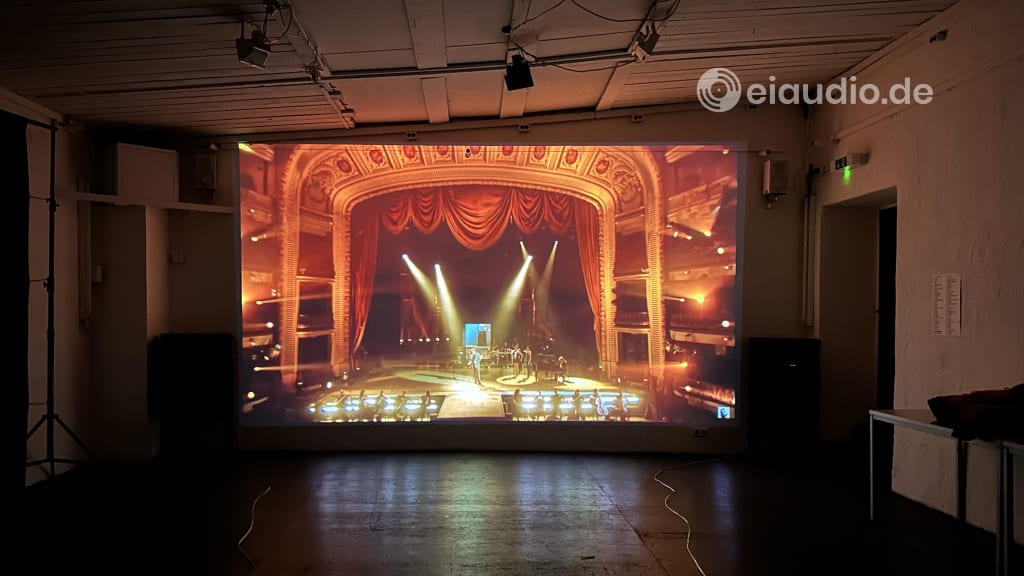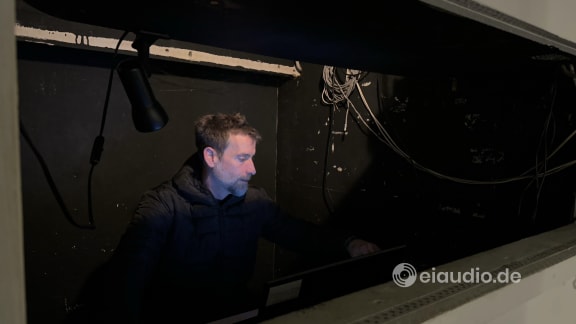Shure 701 Pro Master for Modern PA?
Published: 13/12/2022
Author: Karsten Hein
Category: Explorations
Tag(s): Loudspeakers
When I first carried our freshly acquired Shure 701 Pro Master series speakers from their private seller near Marburg to our car, I remember thinking how unfair it was to be dragging these public address classics from one private household to another. Being in excellent condition, they well deserved to delight audiences at public venues. Back at our house in Frankfurt, I ran some tests and found that they actually had some audiophile potential, at least in the upgraded way they were presented to me, with a new crossover installed and their horn decoupled from the back wall of the speaker cabinet. And so, I proceeded with the construction of two solid wooden stands for them and enjoyed listening to them for a while. This was in June 2022, and I am happy to report that Mark Knopfler’s guitars had never sounded so good at our house.
When my brother approached me shortly before Christmas that year, asking me if I had an idea of which speakers he might recommend to solve the sound issues at the organisation he worked for, I remembered the Shures with their 102 dB of decibel output at just one watt and thought this might just be their chance to play a public venue once again. On the other hand, I did not want to sell my brother an audio solution that was not also in the interest of his employer. Frankfurt’s Gallus Zentrum was a publicly funded youth organisation that did media projects with school children and young adults. They were looking for speakers that would serve as the main sound source at video events with kids and also with the general public. Thus far, they had used a pair of smallish Canton bookshelves for this purpose, of which one had recently died and been replaced with a small JBL Control 1 Pro. Neither of the speakers was ideal for the purpose.
We decided that I would bring the speakers to the Zentrum for auditioning. My brother was kind enough to help my carry them down the many flights of stairs in our building and into the car with me. After all, twenty-six clunky kilos per speaker was an unpleasant load to be carrying alone. I had not been to the Gallus Zentrum for a long time and was happy to find it in the same industrial style design as I had last seen it. The main listening room was almost 14 meters in depth, seven meters in width, and 3,30 meters in height. There was a slightly elevated wooden stage at the front with creaking floor boards and a photo canvas perched along one side wall. The room was almost completely unfurnished, and even the few chairs present were of simple wood and without cushions. There was nothing to prevent the sound from bouncing back from the walls, floor, and ceiling, and I could see that this would lead to some issues.
We first listened to the existing loudspeakers that were driven by an Apart Audio Champ 2 amplifier. I knew this amplifier well and could see that its 200 WPC into 8 Ohms were able to provide enough power for a venue of this size. The Canton speakers had been attached near the ceiling in each of the two corners of the front wall. Jörg played a movie that had been created with the Zentrum’s young customers, and we both had trouble to understand the words that were being spoken. A combination of factors lead to this phenomenon: The source material was a non-professional recording made with non-professional actors. The bookshelf speakers did not give the sound direction. Instead, the sound waves were emitted at a wide angle and consequently bounced around the room. The Cantons being full-range speakers, the corner placement made them sound overly boomy and resonant in the room.
When Jörg turned on a second set of speakers that was connected to another amplifier and mounted on the side walls in the second half of the room, there was a small delay between the sound sources that further muffled the sound. I suggested that we try a different source material, and we switched to Simply Red’s 2005 “Cuba!” concert on YouTube. However, the sound only improved slightly and remained largely unattractive. The big question was, if the Shure 701 Pro Master would be able to improve what seemed to be a hopeless situation. To be honest, I did not know myself, because I had never before set up loudspeakers for public venues. And, considering the width of the speakers, I also understood that our options for placing them in the room were somewhat limited. After all, we did not want the Shures to get in the way of the large video projection area that required most of the front wall surface to remain empty.
My brother operated the audio/video equipment from an elevated control room that oversaw the stage area and could be reached via an old iron ladder. For the Shures to be connected to the Apart Audio amplifier, we had to run a new set of wires from the speakers to the amp. I think we were both more than a little surprised to find that our 2x 25 meter rolls would just be long enough for a permanent installation. We started our sound explorations by placing the Shure speakers at some distance to the front and side walls. They were parallel with the walls, and the resulting sound was less boomy, and high frequency reflections were similarly reduced. When sitting down on the stools in the audience, however, we both noticed that we were only able to listen to one speaker at a time with no trace of stereo-effect. There was also a slight lack of bass in many positions of the room.
When we turned the projector on, the Shures blocked part of the screen area, and we began moving them towards the side corners. Bass performance improved without being boomy or accentuated. And toeing the speakers in towards the center of the room further minimised side wall reflections. There was an unnatural squeakiness to the sound that had been even more prominent with the Cantons that was most likely the result of the bare floor, ceiling and walls, but overall, the resulting sound was much more enjoyable than before. I could now see myself attending an event at this location and reporting positively on the sound. The latter had been quite unthinkable before. And, to our surprise, adding the second pair of speakers to the equation further enhanced the sound in the room. The time delay had disappeared. Adding substance to substance, the large room was now naturally alive with music.
My brother and I ended the evening by putting the speaker cables into the available ducts along the walls and left the scene looking sophisticated and tidy. Following the weekend, Jörg showed his colleagues the resulting sound and discussed the size and usability of the speakers. Everyone agreed that this improvement to sound would raise to appreciation of the film events to a new level with students and the general public. And so it happened that my newly founded eiaudio company officially sold its first set of speakers. I was very proud of having been a part of this improvement of sound quality and also enjoy knowing that the Shures have found a new home in which they naturally belong and can perform at their best.
From the experience, I learned that loudspeakers for public address offered bass response that took into account the characteristics of large rooms and did not so easily lead to an overly bass-heavy sound. Proper PA speakers sounded at their best when driven at higher than living room volumes, simply because the materials used were more difficult to excite and more difficult to break. Horn loudspeakers were designed to minimise room reflections by channeling the sound towards the listener without this bouncing off the side walls on the way. The Shures were quality PA loudspeakers, even after all these years, that served the purpose of the Gallus Zentrum well. I wish Jörg and his team lots of success in their projects next year. May the Shures be with them.
< Watts, Sound Pressure, Decibel | Shure 701 Pro Master Review >





